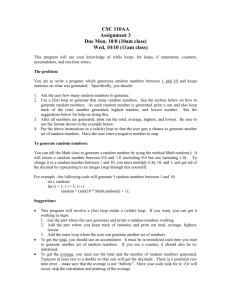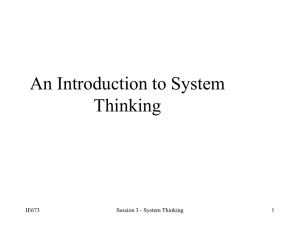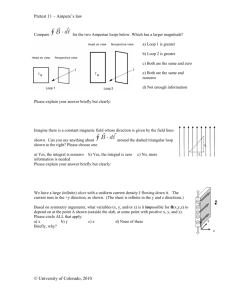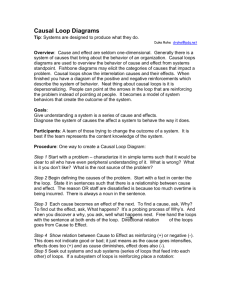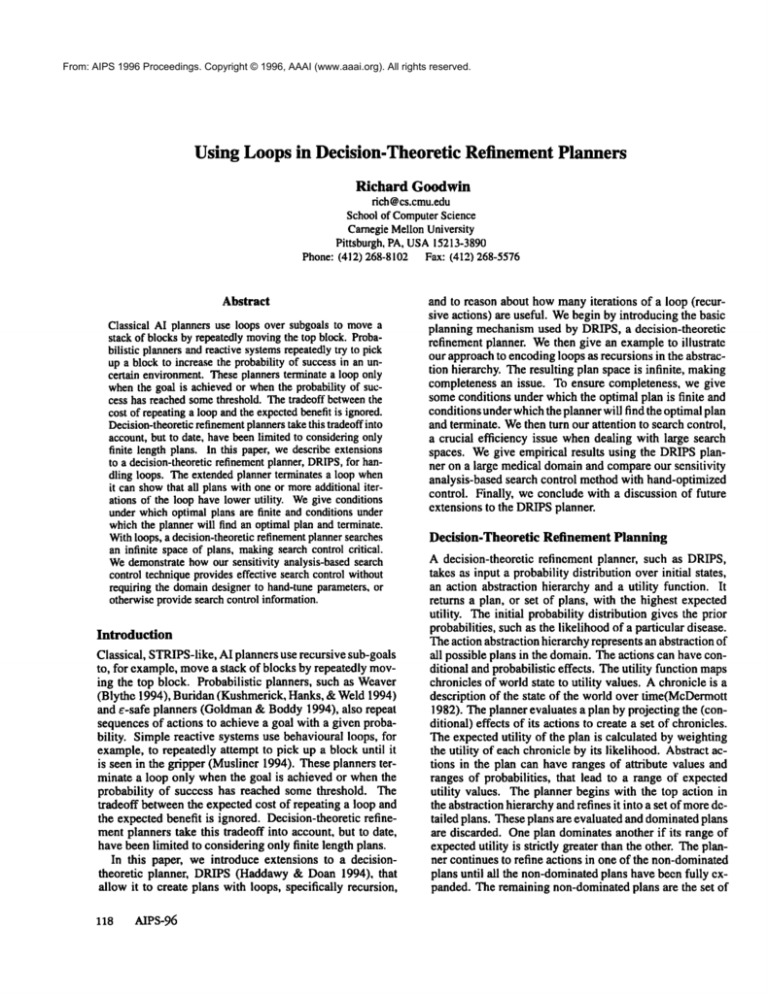
From: AIPS 1996 Proceedings. Copyright © 1996, AAAI (www.aaai.org). All rights reserved.
Using Loops in Decision-Theoretic Refinement Planners
Richard Goodwin
rich@cs.cmu.edu
Schoolof ComputerScience
CarnegieMellonUniversity
Pittsburgh, PA, USA15213-3890
Phone: (412) 268-8102Fax: (412) 268-5576
Abstract
Classical AI planners use loops over subgoalsto movea
stack of blocksby repeatedlymovingthe top block. Probabilistic plannersandreactive systemsrepeatedlytry to pick
up a blockto increasethe probabilityof successin an uncertain environment.Theseplannersterminatea loop only
whenthe goal is achievedor whenthe probability of success has reachedsomethreshold. Thetradeoff betweenthe
cost of repeatinga loopandthe expectedbenefit is ignored.
Decision-theoretic
refinement
plannerstake this tradeoffinto
account,but to date, havebeenlimited to consideringonly
finite length plans. In this paper, wedescribe extensions
to a decision-theoreticrefinementplanner, DRIPS,for handling loops. Theextendedplanner terminates a loop when
it can showthat all plans withone or moreadditionaliterations of the loop havelowerutility. Wegive conditions
underwhichoptimal plans are finite and conditions under
whichthe plannerwill find an optimalplan and terminate.
Withloops, a decision-theoreticrefinementplannersearches
an infinite spaceof plans, makingsearch control critical.
Wedemonstratehowour sensitivity analysis-basedsearch
control techniqueprovideseffective searchcontrol without
requiring the domaindesignerto hand-tuneparameters,or
otherwiseprovidesearchcontrol information.
Introduction
Classical, STRIPS-like,AI planners use recursive sub-goals
to, for example, movea stack of blocks by repeatedly moving the top block. Probabilistic planners, such as Weaver
(Blythc 1994), Buridan (Kushmerick, Hanks, &Weld 1994)
and e-safe planners (Goldman& Boddy1994), also repeat
sequences of actions to achieve a goal with a given probability. Simplereactive systems use behavioural loops, for
example, to repeatedly attempt to pick up a block until it
is seen in the gripper (Musliner 1994). Theseplanners terminate a loop only whenthe goal is achieved or whenthe
probability of succcss has reached some threshold. The
tradeoff betweenthe expected cost of repeating a loop and
the expected benefit is ignored. Decision-theoretic refinementplanners take this tradeoff into account, but to date,
havebeen limited to considering only finite length plans.
In this paper, we introduce extensions to a decisiontheoretic planner, DRIPS(Haddawy& Dean 1994), that
allow it to create plans with loops, specifically recursion,
118 AIPS-96
and to reason about howmanyiterations of a loop (recursire actions) are useful. Webegin by introducing the basic
planning mechanismused by DRIPS,a decision-theoretic
refinement planner. Wethen give an exampleto illustrate
our approachto encodingloops as recursions in the abstraction hierarchy. The resulting plan space is infinite, making
completeness an issue. To ensure completeness, we give
someconditions under whichthe optimal plan is finite and
conditions underwhichthe planner will find the optimal plan
and terminate. Wethen turn our attention to search control,
a crucial efficiency issue whendealing with large search
spaces. Wegive empirical results using the DRIPSplanner on a large medical domainand compareour sensitivity
analysis-based search control methodwith hand-optimized
control. Finally, we conclude with a discussion of future
extensions to the DRIPSplanner.
Decision-Theoretic
Refinement Planning
A decision-theoretic refinement planner, such as DRIPS,
takes as input a probability distribution over initial states,
an action abstraction hierarchy and a utility function. It
returns a plan, or set of plans, with the highest expected
utility. The initial probability distribution gives the prior
probabilities, such as the likelihood of a particular disease.
The action abstraction hierarchy represents an abstraction of
all possible plans in the domain.The actions can have conditional and probabilistic effects. The utility function maps
chronicles of worldstate to utility values. A chronicle is a
description of the state of the world over time(McDermott
1982). Theplanner evaluates a plan by projecting the (conditional) effects of its actions to create a set of chronicles.
Theexpected utility of the plan is calculated by weighting
the utility of each chronicle by its likelihood. Abstract actions in the plan can have ranges of attribute values and
ranges of probabilities, that lead to a range of expected
utility values. The planner begins with the top action in
the abstraction hierarchyand refines it into a set of moredetailed plans. Theseplans are evaluated and dominatedplans
are discarded. One plan dominatesanother if its range of
expectedutility is strictly greater than the other. The planner continues to refine actions in one of the non-dominated
plans until all the non-dominatedplans have been fully expanded. The remaining non-dominatedplans are the set of
From: AIPS 1996 Proceedings. Copyright © 1996, AAAI (www.aaai.org). All rights reserved.
Testl
Result = Positive
Cost = Cost + $160
4/"
Testlor2
. Result -- Negative
Cost ffi Cost + $160
FJ
~
Test I
i~O. Resultffi Positive
Cost = Cost + $160
Result = Negative
Cost -- Cost + $160
(a)~Di ....
0.02.0.05
0.10
Resultffi Positive
Cost = Cost + $300
Test2
0.95_0.98 ] Result = Positive
Cost = Cost + $160_300
I
(c)
0.90
[ Result
Negative
Cost -- =Cost
+ $160_300
Result-- Positive
Costffi Cost + $160..300
I Result
Negative
Costffi =Cost
+ $160..300
. Result = Negative
Cost = Cost + $300
~
Resultffi Positive
Cost = Cost + $300
0.90 I Result = Negative
Cost = Cost + $300
Figure 1: Testl and Test2 are test actions that have different costs and accuracies. Testlor2 is an instance abstraction of the
twotests.
optimal plans.
Action Abstraction
Wefocus nowon the abstraction hierarchy used to encode
the set of possible plans. Encodedin the hierarchy are
instance abstractions and macro abstractions(Haddawy
Doan 1994). Instance abstractions are used to group together a set of actions with similar effects. Macroabstractions are used to summarizesequences of actions.
Consider a simple medical domain with two tests and
a treatment for a disease. Supposethat one test is 95%
accurate for detecting the presence of the disease and costs
$160while the other test is 98%accurate but costs $300.
Both tests are 90%accurate for detecting the absenceof the
disease. Figures la and Ib give the definitions of the two
tests and figure lc gives their abstract instance action. The
actions are conditional and probabilistic. The conditions,
disease = T and disease =F, used to label the branches, are
mutually exclusive and exhaustive. Each conditional branch
can have probabilistic effects, given as a set of changes
to attribute values labeled with their probability. Abstract
actions can have effects with ranges of probabilities and
ranges of attribute values (figure lc).
Onepossible treatment plan is to test for the disease and
treat if the test is positive. For our example,let the cost
of treatment be $5000, which cures the disease with 100%
certainty and let the cost of an untreated case of the disease
be $100,000.Figure 2a gives the definition of the action that
treats the disease if the test result is positive. Thesequence
of a test action followed by a Treat_if Positive action is
abstracted into the macro action given in figure 2b. The
effects of the abstract action summarizethe effects of the
sequence, reducingthe workneededto project the effects of
the sequence. Fully expandingthe Test_&_Treat_if_Positive
action would give two plans, each with two actions. See
(Haddawy & Doan 1994) and (Doan & Haddawy 1995a)
for more details on the abstraction mechanism.
Comparing Treatment
Plans
The planning objective for our simple medical domainis
to create a testing and treatment policy that has the highest
expectedutility (lowest expectedcost). Onepossible plan
to treat the disease unconditionally, whichcosts $5000per
patient. Anotherpossible plan is not to treat anyone.If the
prior probability of the disease is 1/2, then the expectedcost
of not treating anyoneis $50,000.A third option is to use a
test, and to treat if the test is positive. UsingTest22results
in a plan that will treat mostof the patients with the disease
and not treat most of the healthy patients. The expectedcost
is $4000.UsingTest2 is better than alwaystreating or never
treating. However,the plan with Test2 will miss treating
2%of the patients with the disease and will treat 10%of the
healthy patients.
Nowsuppose we repeat the Test2 action if the result is
negative and treat if the first or secondtest is positive i
Withtwo tests, 99.96%of the patients with the disease are
treated but 19%of the healthy patients are also treated. The
tTo simplify our examples,we assumethat repeated actions
are independent,
butin generalthis is nottrue.
Goodwin
119
From: AIPS 1996 Proceedings. Copyright © 1996, AAAI (www.aaai.org). All rights reserved.
Treat_if_Positive
Positive
Tes~Positive
Test lor2
Result = Negative[ Cost = Cost + $5000
0.95..0.98
~ Disease=T
[ Cost=Cost+S100,000
Treat_if_Positive
I
Cost = Cost + $5160..5300
Regult = pngiriv¢
I
\ Result = Negative
\ Disease=F
I
ost = Cost + S 100,1611..100.300
IR~¢uh
~ 1~1~o2t~V
fi
(a)
RP~.lt = r~Ip~mli,t.,p
Dise&qe=
0.10
(b)
[ Cost = Cost + $5160..5300
Regnh = Pngiti~r,g
Figure 2: The sequence of a Testl0r2 action and Treat_if_Positive action (a) are abstracted into a Test_&_Treat_if_Positivc
macroaction (b).
Test.Jf
Disease=-T
Result : Negative~sull
(
Test*
:
Positi~,~
/
/
i[Cost: C.t’4t+ ~160..3fl0}
Te~I_~
i
Test if
[h
[CLot= C,~.t+ $~1~O..3(Xl) [
D .....
F
\
~R~suII
-
PosiU,~
\""
~o,,,’,-_",,~,’~._.
[C,v.,l : C’LSl+ $(INI..3IKI) I
I
Di .... T
Result : NeEative ~ lt.~sult
:Co.q
positive
= Cost + $1160..infinilv|
I
I
1.00’t
(a) Result = IA~,tive
Test*
I
/
Oi=urz=F
~
Result
:
fl~tive
I c,,,,=C,,~+$U(’,O..i~,,,~ity)
I
( Resul,=Nega,ive
~"
m, Reachability
graph.
G’~t= Ct’~t + $1160..infinity)
(h) X Resuh = Pt~silive
1.00 I
L
1
Figure3: The Test_if action applies a Test action if there is no previouspositive tcst result. Test*, a repcatedaction, is either
a single Test_if action or a sequenceof a Test_if action followed by a Test* action. Thearrows showthe teachability graph.
expectedcost of using twotests is $3432, so using twotests
is better than using one test.
If twotests are better than one, then are three tests better
than two? Whatabout four or more tests? Whatabout using
different combinationsof Testl and Test2? In this example,
each time the test is repeated, the likelihood that patients
with the disease will be treated goes up. However,the cost
of the testing and the likelihood that healthy patients will
be treated also goes up. In the limit, if the test is repeated
until there is a positive result, everyonewill be treated. The
expected cost of the plan is the cost of treatment plus the
cost of the expected numberof tests. Clearly, the option
to alwaystreat is better than this and the sequenceof tests
should be terminated whenthe marginal gain is less than
the marginal cost. The problem we address is determining
the numberand types of tests to perform.
Action Abstraction with Recursion
In a decision-theoreticrefinementplanner, the set of possible
plans is represented in an action hierarchy. In the original
version of the DRIPSplanner, the space of plans represented
120 AIPS-96
in the abstraction hierarchywas finite, althougharbitrarily
large. The abstraction hierarchy did not allow recursion, a
natural methodof representing loops. In the this section we
give an exampleusing a recursive action.
Figure 3a defines a conditional action that applies a test
unless a previoustest result waspositive. Figure3b gives the
recursive defnition of the Test* action that includes one or
moreconditional tests. The effects of the Test* action give
the range of possible outcomes.In the limit, the probability
of detecting the diseaseis one, but the probability of a false
positive is also one. The cost can range from the cost of
one test to infinity for an infinite numberof tests. These
conditional effects are used by the planner to evaluate the
boundson the expectedutility of a plan with the Test*action.
The planner begins with a plan that consists of the Test*
action followed by the Treat_if_Positive action. This abstract plan represents all possible sequencesof one or more
tests followedby a treatmentif one of the tests is positive.
The planner proceeds by expandingthe Test* action to create two plans: one with a single test and the other with two
or moretesLs. Eachplan is evaluated to determinethe range
From: AIPS 1996 Proceedings. Copyright © 1996, AAAI (www.aaai.org). All rights reserved.
of expectedutility. If either plan is dominated,it is pruned
from the search space. Expansionof the Test* action continues until the upper boundon the plan with the recursive
action falls belowthe lower boundon one of the plans with
a finite number of tests. The planner terminates when a
dominantplan is found. In this example, the planner terminateswith a plan that has twotest actions, a Test I action
followed by a Test2 action, which is the optimal plan with
an expected cost of $3325.
Method for Encoding Loops
A loop is a sequenceof actions that is repeated one or more
times until some condition is reached. The body of the
loop is represented by a conditional action that applies the
sequenceof actions unless the conditionholds. If the condition holds, the action has no effect. Test_if is an exampleof
suchan action that applies a test unless a previoustest result
was positive. A sequence of one or more repetitions of the
loop is represented as an instance action that expandsinto
a single action or into a macroaction that, in turn, expands
into a single action followed by the repeated action (Figure
3b).
The conditional effects of the repeated action can be derived fromthe effects of the action that formthe bodyof the
loop. Wesketch here a methodfor doing this using a reachability graph. A teachability graph is created by connecting
a directed arc from each effect in the conditional action to
every effect that could be reachedin the next iteration of the
loop, except for the null effect used to terminate the loop.
The arrows in figure 3a give the teachability graph for the
test_if action. Eachof the effects with a negativeresult can
loop backto itself or to the effect withthe positive result on
the next iteration of the loop. Effects with a positive result
will terminate the loop on the next iteration and have no
outgoing arrow.
To determinethe boundson the probabilities, we begin by
assigning each node in the reachability graph the probability
of the effect in the conditional action. The reachability
graph showshowthis probability mass can flow as the loop
is unrolled. The upper boundon probability is the upper
boundon the sumof the probabilities that could flow into a
node, plus its initial value. For example,the boundfor the
first condition in Test* is [0.95... 0.98] + [0.02... 0.05] =
[0.97... 1.03] =~ 1.00. The lower bound will be zero if
there is an edge leading from the node, otherwise the lower
boundis the initial value. In the example,the lower bound
on probability for the sameconditions is the initial value,
[0.95... 0.98] =:. 0.95.
Attribute values are also assigned using the reachability graph. If an effect in the conditional action assigns an
attribute a specific value, then the effect in the repeatedaction assigns the attribute the samevalue (Result = Positive
for example). Otherwise, the effect on the attribute must
include the effects along any path that reaches the effects
node. In the case of a loop, we need to find the boundsfor
a single cycle of the loop and the boundsas the numberof
cycles of the loop approachesinfinity. For the self loop in
the case of a negative result, costi+l = costi + [160..300].
The numberof iterations ranges from I to oo and the bounds
on cost are the boundson the recursive equation. Since the
recurrence equation is monotonicallyincreasing for increasing i, the minimum
value occurs for i = 1 and the maximum
value occurs at i ffi oo. Takingthe limit as i -~ oo gives
costoo = costo + $oo. The resulting conditional effect is
cost =costo + $[160... oo]
Our methodof encoding loops ensures that the repeated
action contains at least one iteration of the loop. Theeffects
of the repeatedaction then do not haveto include the effects
of zero iterations of the loop. This provides tighter bounds
on the range of effects and allows plans with loops to be
prunedwith fewer unrollings of the loop. Since the cost of
projecting a plan is exponential in the length of the plan,
saving one loop unrolling leads to significant performance
improvements.
In related work, Ngoand Haddawygive a constructive
methodfor generating the conditional effects for a loop
repeated up to N times (Ngo & Haddawy1995). The method
reformulates the conditional effects of the repeated action
and can lead to tighter boundsin somecases. Their method
could be extendedto workfor infinite loops by using limits
as N approachesinfinity.
Finding Optimal Plans with Finite
Length
In the simple medical domain,the optimal plan is a finite
sequenceof actions. In general, the value of repeatedinformationgathering actions, like a medical test, is limited by
the value of perfect information. The planner will expand
the recursive action until the value of informationfrom the
test is less than the cost of the test, and begins to lowerthe
upper boundon expected utility. Whenthe upper expected
utility boundon the plan with the infinite action falls below
the lower boundon the expected utility of another plan, it
can be pruned. This methodof pruning constitutes a proof
that the infinite plan is not an optimalplan.
As with any proof method, we must be concerned about
soundnessand completeness. The result is soundif optimal
plans are not pruned, while it is complete if all the suboptimal plans are pruned and the planner terminates. The
soundness of the planning methodis discussed in (Doan
Haddawy
1995b). In this section, we give sufficient conditions for ensuringthat optimalplans are finite and sufficient
conditions for the DRIPSplanner to find the optimal plans
and terminate.
Since the algorithm terminates only whenthe set of potentially optimal plans can no longer be expanded,the algorithm will never terminate whenthe optimal plan consists
of an infinite sequence of actions. Consider, for example,
a domainwhere a robot is trying to pick up a cup. Suppose there is a single pick_up_cupaction that succeeds with
probability 0.5 and that the value of holding the cup is I and
the cost of trying to pick it up is 0.1. The expected value
of trying to pick up the cup onceis 0.4. If the action fails,
we are back in the original state. Assumingindependence,
the expectedutility of two attempts to pick up the cup is
0.6. As the numberof pick up attempts is increased, the
expected utility asymptotically approachesthe value of the
Goodwin
121
From: AIPS 1996 Proceedings. Copyright © 1996, AAAI (www.aaai.org). All rights reserved.
infinite plan, 0.8. The planner can not recognize that the
optimal plan is infinite and will attempt to unroll the loop
indefinitely.
Fortunately, in manydomains the optimal plan is not
infinite. Wecan ensure that this is the case by imposing
conditions on the domainand conditions on the domaindescription that allow the planner to determinewheninfinite
plans can be pruned. The optimal plan will be finite if,
after somefixed numberof unrollings, the marginal utility
of unrolling the loop once more is negative and, for each
additional unrolling, the marginal utility is non-positive.
Underthese conditions, the expectedutility of the infinite
plan will converge to minus infinity, or somesub-optimal
finite value. The same condition can be imposedon the upper boundon expected utilities for plans generated fromthe
domaindescription, including plans with abstract actions.
This ensures that plans with infinite recursion can be pruned
after somenumberof unrollings of each loop. For the previous cup example, we can ensure termination by making
the utility function time dependent and have the value of
picking up the cup becomezero after five minutes.
There are manypossible restrictions on the encodingof a
domainand a utility function that can enforce the sufficient
conditions necessary to ensure finite length optimal plans.
Thesecan include restrictions on the form of the utility
function and restrictions on the actions in the domain.One
methodis to have each iteration of a loop consumesome
finite amountof a limited resource. Plans that violate the
resource limit are assigned low utility. Ngoand Haddawy
have proposed using this method (Ngo & Haddawy1995).
Resourcelimits are used to calculate a limit on useful loop
iterations, and the domainis encoded to only allow that
manyiterations of the loop. Williamson and Hanks use
a morerestrictive condition that limits all resources and
allows only deadline goals (Williamson & Hanks 1994).
Theyuse these restrictions to do optimal planning with a
partial order planner.
Handling Infinite
Length Optimal Plans
For some domain descriptions, the optimal plan may include an infinite loop. The optimal plan for the pick_up_cup
exampleis an infinite sequence of attempts to pick up a
cup. In practice, it is impractical to attempt to execute a
plan with an infinite loop. The appearance of an infinite
loop in an optimal plan is likely caused by limited fidelity
in the domainmodelor the utility function. Oneach iteration of the pick_up_cup
action, the marginalutility is cut in
half. At somepoint, using the difference in expectedutility
for a finite length plan and an infinite length plan will not
be justified by the precision of the probability and attribute
value estimates used to calculate the expected value. Independenceassumptionsalso limit modelfidelity. In the cup
example,the probability of success for subsequentattempts
to pick up the cup maynot be independent. An unmodeled
attribute, like the cup being too big, mayprevent the cup
from ever being grasped. Failure on the first attempt should
serve as evidence to lower the probability of success on
subsequenttrials, leading to an optimal plan with a finite
122 AIPS-96
numberof repetitions.
To keep the DRIPSplanner from trying to enumerate
all the actions in an infinite optimal plan, we add two additional pruning methods for plans with loops. Weprune
infinite plans whenthe differencein expectedutility for a finite plan and the infinite plan is less than the accuracyof the
numbersused to calculate the expected utility. This method
also helps to deal with problemsdue to numerical roundoff
errors. Wealso prune infinite plans whenthe difference
in expected utility is not justified by the computationtime
neededto unroll the loop one more time. For offline planning, we use a user supplied function to mapcomputation
time to cost (negative utility). Werequire the cost function
to monotonicallyincrease with increased time. Since each
unrolling of a loop lengthens the plan to be evaluated and
plan evaluation time is exponentialin the length of the plan,
this condition is sufficient to ensure planner termination.
For online planning, the the utility function could be used
determine the cost of delaying execution.
Search Control for Infinite Plan Spaces
With the introduction of loops and the resulting infinite
plan spaces, search control becomeseven more crucial for
efficient planning. In previous work, we have shownthat
an optimal policy exists for choosing whichplan to expand
next and that search efficiency dependsonly on whichaction
within this plan is selected for expansion(Haddawy,Doan,
&Goodwin1995). In this section, we discuss the factors
that affect search efficiency and describe extensions to our
sensitivity analysis-based search control method(Goodwin
1994)that allow it to deal with loops. In the next section,
we comparethree search heuristics using a large medical
domainwith loops.
A key question for search control in domainswith loops
is whento unroll the loop. Expandingthe recursive action
preferentially can result in having to evaluate very long
plans. Theloop has to be unrolled until the falling marginal
utility of each unrolling causes the upperboundon expected
utility to drop belowthe lowerboundfor somefinite length
plan. Withabstract actions, the range of expected utility
for the finite length plans can be large, leading to excessive
unrolling. Evaluating these long plans is expensive since
the cost of projection is exponential in the length of the
plan. On the other hand, expandingrecursive actions only
whenall other actions have been fully expandedcreates
tighter boundson the expectedutility of finite length plans
but creates manyplans with recursive actions that mayhave
to have their loops unrolled.
Since it is the upper boundon expected utility that is
used to prune a plan, a goodstrategy is to select expansions that will have the largest effect on reducing the upper bound, taking into account the amountof computation
needed. Approximatingthis strategy is the idea behind
sensitivity analysis-based search control. The domaindescription of actions in the plan and the utility function are
used by the planner to determine the maximum
change in
the upper boundfor fully expandingan abstract action into
primitive actions. This value is then divided by an estimate
From: AIPS 1996 Proceedings. Copyright © 1996, AAAI (www.aaai.org). All rights reserved.
800
e¯
Loops ,/
700 ....PreferUnrolling
---PreferNotUnrolling
Loops,/
~.
6O0 ¯ ---.
Sensitivity
Analysis //Z/ "~
500
j
i .’/J/"
1/ 111
4O0
/ 111
i¯ 11
¯t"11
11
,
300
200
100
0
50
.,.~
¯ --- Prefer Unrolling Loops
--- Prefer Not Unrolling Loo,I~
..... Sensitivity Analysis
/
i
/I
35000
30000
25000
I
It
20000
/
1
1
15000
10000
t/
!
Jti
/
!t
5000
100
150 200 250 300
Cost of Fatality ($1000)
Execution Time Versus Cost of Fatality
0
0
200
400
600 800 1000 1200
Cost of Fatality ($1000)
Execution Time Versus Cost of Fatality
Figure 4: Empirical results showingrunning time versus cost of fatality for three search control methodsand for two ranges
of the cost of fatality. Thegraphon the left is an enlargementof part of the graphon the right.
of the work needed to fully expandthe action. This ratio
is an estimate of the rate of lowering the upper boundon
expected utility per unit of computation. The action with
the highest ratio is chosenfor expansion.
To use the sensitivity methodfor recursive actions, we
cannot calculate the maximum
possible change in expected
utility from fully expandingthe action and then divide it by
the work needed to fully expand the action. Both numbers
could be infinite. Instead, we estimate the rate by considering only a single unrolling of the loop. A boundon
the change in expected utility can be calculated using the
changein attribute values for a single iteration of the loop.
The work needed is two plan evaluations, one with one more
iteration and the other with one or moreiterations. Again,
the plan with the highest expected ratio of boundslowering
to workis chosen for expansion.
In previous work, we had used the numberof plan evaluations as an estimate of the amountof computation. This
is appropriate when each plan evaluation takes approximately the same amount of computation. With loops, the
length of plans can vary significantly. Since plan evaluation is exponential in the length of the plan, the number
of plan evaluations is not a goodmeasure of computation.
Instead, we use the structure of the action being expanded
to weight the numberof plan evaluations by relative computation cost. Instance actions that expandinto a single
action do not lengthen the plan and have a relative cost of
one. Sequenceactions lengthen the plan by the numberof
actions in the sequence minusone. Their relative weight is
the averagebranchingfactor raised to the increase in length,
(-b) z’t°~sth. In our experience, using the newmeasureleads
to more plan evaluations, but less computationon average.
Empirical Results
The DRIPSplanner has been used to analyze treatment policies for deep venous thrombosis (DVT)(Haddawy,Kahn,
&Doan1995). The domain model is taken from a study in
the medicalliterature that evaluated treatmentpolicies, ineluding repeated tests (Hillner, Philbriek, & Beeker1992).
The domain consists of a model of how the disease can
progress over time and the actions available to the doctor
whichinclude a numberof tests and a treatment. The planning objective is to create a testing and treatment policy
with the highest expected utility. The original encoding of
the domainfor the DRIPSplanner allowed up to three tests
before a decision to treat was made. Wehave extended the
domainto use loops so that the planner can determine how
manytests are useful.
Wehave run a series of experiments using the modified
DVTdomain to compare the performance of three search
control strategies. In the experiments, we vary the cost of
fatality. For a very lowcost of fatality, the optimalplan is
not to test or treat anyone.Asthe cost of fatality rises, the
optimal plan includes more tests to improvethe likelihood
of detecting the disease and treats the patient whenthe test
results are positive. Addingmoretests increases the probability that the patients will suffer side effects fromthe tests,
whichcan lead to death in someeases. A utility function is
used to weighthe relative benefits.
The DRIPSplanner allows the user to supply search control informationby assigning relative priorities for expanding to each abstract action. To evaluate the performance
of our sensitivity analysis method, we have comparedit to
two hand-tuned priority schemes. One priority schemewas
optimized to produce good performance for a low cost of
fatality and generally prefers unrolling loops. The other
was optimizedfor higher costs of fatality and prefers not
unrolling loops.
In the DVTdomain,deciding whento unroll the test loops
can have a significant affect on performance,especially for
harder problems.For low costs of fatality, preferentially unrolling the loop quickly showsthat moretests are not utile,
and the plan with the loop is quickly pruned. However,
these problemsare easily solved and the time difference is
Goodwin
123
From: AIPS 1996 Proceedings. Copyright © 1996, AAAI (www.aaai.org). All rights reserved.
minimal(figure 4). For higher costs of fatality, preferentially expandingother abstract actions leads to evaluating
shorter plans on average, which gives muchbetter time
performance.The sensitivity analysis-based search control
tends to follow the best strategy at each extreme. At low
costs of fatality, all three methodsevaluate few plans (between9 and 13). There are relatively few choice points and
makinga bad decision does not lead to excessive computation. The overheadof doing the sensitivity analysis calculation can not be fully compensatedfor by makingbetter
decisions. At higher costs of fatality, there are significant
numbersof choice points and makinggood decisions leads
to significant speed improvements.As the cost of fatality
increases, the performanceof the sensitivity analysis-based
methodapproaches and eventually out performs the priority methodoptimized for high costs of fatality. In these
harder problems, the improvementin decision quality more
than compensatesfor the cost of the sensitivity analysis.
Thesensitivity analysis-based methodadapts to the specific
problemto provide efficient search control over the range of
planning problemsconsidered. This is done without requiring the user to supply additional search control information.
Discussion
This paper describes a decision-theoretic refinement planner
extended to handle loops of repeated actions. Wegave
conditions under which the optimal plan will be finite and
conditions under whichthe planner will find the optimal plan
and terminate. To deal with infinite optimal plans, we have
introduced two additional criteria for pruning plans with
infinite loops: prune whenthe expected cost of computation
exceeds any possible benefit and whenthe difference in
expectedutility is less than the accuracyof the values used
in the domaindescription. Wehave demonstrated howour
sensitivity analysis-based search control methodprovides
effective search control, without burdeningthe user.
Onearea of concern for the DRIPSplanner is that it requires the domaindesigner to decide which conditions to
use for conditional actions. In our medical example, we allowedrepeated tests if the result was negative. It mayalso
be useful to allow repeated tests if the result was positive.
This wouldbe useful if the treatment was almost as bad as
the disease. Weare currently workingon methodsto allow
a decision-theoretic refinementplanner to automatically decide whichconditions to use for loop termination.
Acknowledgements
This research was partially sponsored by NASAunder
grants NAGW-3863
and NAGWI ! 75. I wish to thank Reid
Simmonsfor manyuseful discussions and commentson this
paper. I also wish to thank Peter Haddawyfor makingthe
DRIPSplanner available.
References
Blythe, J. 1994. Planning with extcrnal events. In
de Mantras, R. L., and Poole, D., eds., Proceedingsof the
Tenth Conferenceon Uncertaintyb~ Artificial Intelligence,
94-101.
124 AIPS-96
Doan, A., and Haddawy,P. 1995a. Generating macro operators for decision-theoretic planning. In WorkingNotes
of the AAA! Spring Symposiumon Extending Theories of
Action.
Doan, A. H., and Haddawy,P. 1995b. Decision-theoretic
refinement planning: Principles and application. Technical Report TR-95-01-01, Dept of Elect. Eng & Computer
Science, University of Wisonsin-Milwaukee.
Goldman,R. P., and Boddy,M. S. 1994. Epsilon-safe planning. In de Mantras, R. L., and Poole, D., eds., Proceedings of the Tenth Conferenceon Uncertainty bl Artificial
Intelligence, 253-261.
Goodwin, R. 1994. Reasoning about what to plan. In
Proceedings,Twelfth National Conferenceon Artificial Intelligence. AAAI.
Haddawy,E, and Doan,A. 1994. Abstracting probabilistic
actions. In de Mantras,R. L., and Poole, D., eds., Proceedings of the Tenth Conferenceon Uncertainty b~ Artificial
Intelligence, 270-277.
Haddawy,E; Doan, A.; and Goodwin,R. 1995. Efficient
decision-theoretic planning techniques. In Besnard,E, and
Hanks, S., eds., Proceedingsof the Eleventh Conference
on Uncertaint), in Artificial Intelligence, 229-236.
Haddawy,E; Kahn, Jr, C.; and Doan, A. 1995. Decisiontheoretic refinement planning in medical decision making:
Managementof acute deep venous thrombosis. (submitted to Medical Decision Making). (submitted to Medical
Decision Making).
Hiliner, B. E.; Philbrick, J. T.; and Becker, D. M. 1992.
Optimal managementof suspected lower-extremity deep
vein thrombosis: an evaluation with cost assessment of 24
managementstrategies. Arch Intern Med152:165-175.
Kushmerick, N.; Hanks, S.; and Weld, D. 1994. An
algorithm for probabilistic least-commentmentplanning.
In Proceedings,Twelfth National Conferenceon Artificial
Intelligence, 1073-1078. AAAI.
McDermott,D. 1982. A temporal logic forreasoningabout
processes and plans. CognitiveScience 6(2): I 0 I-155.
Musliner, D.J. 1994. Using abstraction and nondeterminism to plan reactive loops. In Proceedings, Twelfth National Conferenceon Artificial Intelligence, 1036-104I.
AAAI.
Ngo, L., and Haddawy,E 1995. Representing iterative
loops for decision-theoretic planning(preliminaryreport).
In Working Notes of the AAA! Spring Symposiumon Extending Theories t~’Action.
Williamson, M., and Hanks, S. 1994. Optimal planning with a goal--directed utility model. In Hammond,
K., ed., Proceedingsof the SecondInternational Cm~’erence (AIPS94),176-18I. Artificial Intelligence Planning
Systems.


